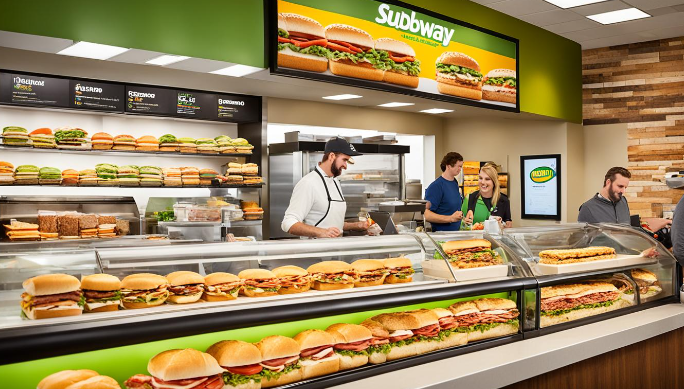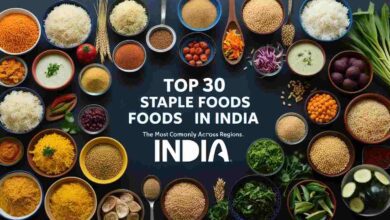The 20 Biggest fast food restaurants in the United States
"Ranking America's Most Popular Quick-Service Chains"

The fast food industry in the United States is huge and profitable. It has over 50,000 fast food chains across the country. The top names include McDonald’s, Starbucks, Subway, Taco Bell, and Burger King.
These chains succeed by offering a wide variety of foods and strong brand identities. They use marketing and advertising to stand out.
Looking at the top 30 largest food chains in the US, McDonald’s is at the top with 40,275 locations. It made US$23.2 billion in 2021. Subway has 36,999 locations and made US$16.1 billion. Starbucks has 36,170 locations and earned US$32.3 billion in 2022.
The top 20 biggest fast food chains in America show the industry’s growth and changing tastes. They’ve expanded, introduced new items, and used technology to meet what people want. From McDonald’s to Starbucks, the fast food scene in the US is always changing.
Key Takeaways
- The US fast food industry is a vast and lucrative market with over 50,000 chains nationwide.
- McDonald’s, Starbucks, and Subway are the largest fast food chains by number of locations and revenue.
- The top 20 biggest fast food chains in America have strategically expanded, innovated, and adapted to changing consumer trends.
- The fast food landscape in the US is dynamic and ever-evolving, with chains constantly vying for market share and consumer loyalty.
- Understanding the industry’s key players and their performance metrics provides valuable insights into the fast food landscape in the United States.
Fast Food Industry Overview
The fast food industry is a big part of American food culture. It meets the need for quick, affordable meals with a wide range of choices. The market size is huge, over $198.9 billion in the U.S., and it’s expected to grow even more, reaching over $223 billion by 2020.
Economic Impact and Growth Projections
Fast food is a big job creator in America. The top four companies bring in a lot of the revenue, showing how concentrated the market is. Smaller companies face tough competition in this sector.
Worldwide, fast food is set to grow a lot, from $972.74 billion in 2021 to $1,467.04 billion by 2028. This means a 6.05% growth rate each year. The European market is the biggest, making up almost 39% of the global fast food market in 2020.
Consumer Trends and Preferences
People still love fast food for its ease and price. But, worries about health issues like obesity are making people look for healthier choices. Fast food chains are now offering healthier options and being more open about nutrition.
The fast food industry must balance what customers want with health concerns. It’s important for the industry’s future success to adapt to these changes.
McDonald’s: The Golden Arches Empire
Historical Background and Expansion
McDonald’s is a top American fast-food chain with a long history. It started in 1940 by the McDonald brothers in San Bernardino, California. The first place was a small drive-in called “McDonald’s Bar-B-Q.”
In 1948, the brothers changed their concept with the Speedee Service System. They focused on burgers, fries, and shakes. This change was a big hit.
Ray Kroc, a milkshake mixer salesman, joined McDonald’s in 1955. He saw the chance to grow the brand nationwide. He opened the first franchise in Des Plaines, Illinois. By 1959, there were 102 McDonald’s restaurants.
Now, McDonald’s is in over 100 countries, serving millions every day. It’s a global fast food leader. The brand’s success comes from its focus on quality, efficiency, and new menu items.
Menu Offerings and Brand Innovations
McDonald’s has updated its menu over the years. It now offers everything from classic burgers to healthier choices. This shows the company’s ability to change and innovate.
The Big Mac, introduced in 1968, is a famous McDonald’s item. It’s a double-decker burger that became very popular. The company also offers breakfast items like the Egg McMuffin, which are loved by many.
Recently, McDonald’s added salads, wraps, and plant-based burgers. These new items meet the demand for healthier fast food. These changes keep the brand interesting to a wide range of customers.
“McDonald’s has revolutionized the fast-food industry with its focus on speed, consistency, and a limited menu, setting new industry standards.”
Starbucks: The Rise of the Coffee Connoisseur
Starbucks has become a big name in fast food, with over 13,900 locations in the U.S. It has grown by offering specialty coffee drinks and the “fast casual” dining trend. This trend means people want a better dining experience that’s quick.
Starbucks is known for its high-quality coffee and new menu items. It has a unique brand that attracts coffee connoisseurs. Now, over 70% of its sales come from mobile apps and drive-thru orders.
The COVID-19 pandemic hit Starbucks hard, causing a 3% drop in sales in North America. But, the company bounced back. It invested in better coffee equipment for employees and saw a big increase in mobile ordering. Now, mobile orders make up over 30% of its sales.
Starbucks is a leader in the fast casual market. It plans to open 2,000 new stores, including different types like pick-up and delivery-only ones. This shows Starbucks’ commitment to adapting to new consumer trends in fast food.
“Starbucks is not just a coffee company, but a company that sells an experience.”
Starbucks keeps growing and innovating. It remains a top player in the fast casual market. It meets the tastes of coffee connoisseurs and sets the standard for the industry.
Subway: The Sandwich Sensation
Subway is the biggest fast-food chain in the world, with 25,908 locations in the U.S. alone. It’s known for its healthy and customizable sandwiches. This focus has helped it grow fast, both in the U.S. and around the world.
Franchise Model and Global Reach
Subway uses a franchise model to grow quickly. This has given it a wide network of locations across the U.S. It has also helped the brand expand globally, with over 36,000 stores in more than 100 countries.
However, Subway has faced challenges in some areas. In places where certain food additives are banned, like azodicarbonamide, it has changed its menu. This was to meet local laws and what customers want.
“Subway has been able to capitalize on the growing demand for healthier fast-food options, offering customers the ability to customize their sandwiches with a wide variety of fresh ingredients.”
Even with challenges, Subway’s franchise model has helped it grow globally. It has quickly expanded and entered new markets. The brand’s focus on a convenient, customizable sandwich has made it a top choice in fast food.
Taco Bell: Mexican-Inspired Fast Food
Taco Bell is a big name in US fast food, thanks to Yum! Brands. It has over 8,200 locations across the country. The brand’s success comes from its fresh take on Mexican food. It keeps updating its menu to match what people want, making sure it stays interesting.
Menu Innovations and Marketing Campaigns
Taco Bell is loved for its new and tasty menu items. The Nacho Fries are a big hit, added in 2018. They’ve become a staple. Also, the Baja Blast drink, thanks to its partnership with Mountain Dew, has won over many fans.
The brand’s fun and bold ads have helped build a strong identity. Its marketing, like “Taco Tuesdays” and the “Breakfast Crunchwrap,” really connects with people. This has made a loyal customer base.
“Taco Bell serves billions of people worldwide, and its innovative menu items and strategic marketing campaigns have solidified its position as a leader in the Mexican-inspired fast-food segment.”
Taco Bell is growing, planning to open 300 more locations by 2022. Keeping up with trends and offering something new will keep it ahead. With a focus on a unique Mexican-inspired taste, Taco Bell is a big player in fast food.
Burger King: The Flame-Grilled Favorite
Burger King is the second-largest burger chain in the U.S. It has over 7,266 locations and makes about $1,387.81 per unit. This makes it a top name in fast food, known for its quality burgers.
The brand stays ahead thanks to smart branding and marketing. It focuses on unique cooking and products like the Royal Crispy Chicken Sandwich and Wrap. These items meet what customers want today.
The flame-grilled chicken sandwiches and wraps come in four flavors: Classic, Fiery, Bacon, and Swiss. They’re made over an open fire, which means less oil and a healthier choice for customers.
In 2021, Burger King made its Whopper tastier by removing artificial ingredients. This change got a lot of positive feedback online. The $1 Your Way Menu, launched in December 2020, offers great value and keeps prices low.
For over 70 years, Burger King has been known for its flame-grilling. This skill keeps it unique in fast food. With a focus on quality, new ideas, and making customers happy, it’s a top choice for burger and fast food fans.
“Burger King has been flame-cooking its burgers since it opened in 1954, and that commitment to quality and taste is what sets us apart.”
Burger King keeps changing to meet its customers’ needs. Its status as a flame-grilled favorite is strong among fast food lovers in the United States.
Fast Food and Health Concerns
The fast-food industry has grown quickly, raising big health worries. Studies show that eating too much fast food can harm both short and long-term health. It can lead to obesity, diabetes, and even cancer.
Nutritional Information and Transparency
Many fast-food chains have been criticized for not being clear about their food’s nutritional info. A 2015 review found that fast food is often full of sugar, salt, and unhealthy fats. It often lacks fruits and veggies. This makes it hard for people who care about health to choose wisely.
Healthy Alternatives and Menu Adaptations
Some fast-food chains are now offering healthier choices in response to customer demand. They have salads, grilled or baked meals, and plant-based options. These are a nice change from the usual high-calorie, high-fat foods.
| Health Concern | Impact of Fast Food Consumption |
|---|---|
| Obesity and Diabetes | Eating too much fast food can make you gain weight and increase the risk of obesity and type 2 diabetes. |
| Cardiovascular Disease | Fast food is high in salt, saturated fats, and trans fats. These can cause high blood pressure, cholesterol problems, and heart disease. |
| Cognitive Decline | Eating fast food often can lead to poor brain function and raise the risk of Alzheimer’s and Parkinson’s diseases. |
| Mental Health | Fast food has been linked to bad mental health, including more depression and anxiety. |
As people pay more attention to their health, fast-food companies must change their menus and practices. They need to offer healthier choices and be more open about what they serve.
Pizza Hut: A Slice of Americana
Delivery Services and Technology Advancements
Pizza Hut is a well-known fast-food chain in the U.S. It has over 7,500 locations across the country. This makes it a top choice for pizza lovers for many years. The brand has grown by keeping up with new trends and tech.
Pizza Hut was ahead of its time with PizzaNet in 1994. This was one of the first online ordering systems. Now, customers can order their favorite pizzas easily with their phones or voice devices.
The company has also used new tech like virtual reality and augmented reality. These tools make ordering pizza more fun and interactive. They’ve made getting your pizza even more exciting.
Pizza Hut keeps leading in the fast-food pizza market by focusing on delivery and tech. It meets what customers want and need. As things change, Pizza Hut’s drive for new ideas and changes will keep it a favorite Pizza Hut brand.
“Pizza Hut has consistently adapted to evolving consumer trends and technological advancements, cementing its status as a beloved American pizza brand.”
Wendy’s: The Fresh, Never Frozen Contender
In the fast-paced world of burgers, Wendy’s stands out as the “fresh, never frozen” choice. It’s the third-largest burger chain in the U.S., with over 6,500 outlets across the country. Each outlet brings in an average of $1,610 in sales.
Wendy’s commitment to quality and freshness has made it a success. The brand does thousands of beef runs to its outlets every week. This ensures the meat is always fresh. About one-third of Wendy’s meat suppliers cut down on antibiotic use in cattle feed, showing the brand’s dedication to quality.
Wendy’s doesn’t just focus on the beef. Its square-shaped patties show its practical approach to quality and consistency. Even when Wendy’s thought about changing to round patties in the late 2000s, it stuck with the square shape for good reasons.
Wendy’s menu is also a big part of its success. It offers seven different burger categories, from Jr. burgers to Baconators. A recent review found the Big Bacon burgers to be a highlight, with four great options.
As fast food changes, Wendy’s has shown it can adapt and stay strong. With a focus on freshness, quality, and new ideas, Wendy’s is set to keep being a top contender in the burger and fast food world.
| Wendy’s Fast Facts | Value |
|---|---|
| Number of U.S. Locations | Over 6,500 |
| Average Sales per Unit | $1,610 |
| Worldwide Locations | Over 7,000 |
| Beef Suppliers with Reduced Antibiotic Use | About 1/3 |
| Burger Categories Offered | 7 |
Fast Food Chains and Sustainability
More people are thinking about the environment and sustainability. Fast-food chains are starting to act too. They’re making changes to be kinder to the planet. This shift is a big deal for them, as they used to be known for being bad for the environment.
Eco-Friendly Practices and Initiatives
Fast-food chains are trying new things to be more green. They want to make less pollution and take better care of the earth. Here are some ways they’re doing this:
- Using wind and solar power to cut down on energy use and pollution.
- Switching to reusable containers to reduce trash and plastic waste.
- Starting recycling programs to keep waste out of landfills and support recycling.
- Buying ingredients from local farms to use less nonrenewable resources and cut down on fuel use.
- Upgrading to appliances and lights that use less energy to help the planet more.
- Turning food waste into compost and recycling cooking oil to make less waste and pollution.
By doing these things, fast-food chains are making a positive change. They’re showing they care about the planet. And they’re winning over customers who also care about the environment.
| Sustainability Initiative | Impact |
|---|---|
| Renewable Energy Investment | Reduced energy consumption and greenhouse gas emissions |
| Reusable Packaging Transition | Decreased waste and plastic pollution |
| Robust Recycling Programs | Diversion of waste from landfills and promotion of circularity |
| Local Ingredient Sourcing | Decreased reliance on nonrenewable resources and lower transportation-related emissions |
| Energy-Efficient Appliances and Lighting | Enhanced sustainability and reduced energy consumption |
| Composting and Used Cooking Oil Recycling | Minimized waste and emissions |
Fast-food chains are making big changes to be more eco-friendly. They’re not just doing it for the planet. They’re also winning over customers who want to make a difference.
Domino’s: Delivering Convenience and Innovation
Domino’s is a top pizza chain in the U.S., known for its focus on delivery and tech. It has over 5,587 locations across the country, making about $1,000 per unit on average. This shows how strong its delivery network and digital tools are.
Domino’s has made big strides in tech to meet today’s pizza lovers’ needs. Since starting online and mobile ordering in 2007, over 85% of its sales come from digital channels. This shows its big push for tech solutions.
Domino’s keeps innovating, like with the Domino’s DXP vehicle for pizza delivery. It also has the Pinpoint Delivery feature, letting customers get their orders at different spots. These efforts make ordering easier and show Domino’s commitment to making things better.
Domino’s is a giant globally, with over 20,700 stores in more than 90 countries. It made $18.3 billion in sales worldwide in 2023. Its drive to offer great service, use tech, and adapt to trends has led to its success.
| Key Milestones | Year |
|---|---|
| Opened its 1,000th store in the U.S. | 1983 |
| Rolled out its 30-Minute Guarantee | 1993 |
| Opened its 6,000th store in San Francisco | 1998 |
| Completed a three-year renovation of its World Resource Center in Ann Arbor, Michigan | 2005 |
| Opened its 9,000th store worldwide | 2010 |
| Won “Chain of the Year” by Pizza Today Magazine for the second consecutive year | 2011 |
| Opened its first store in Thailand and introduced a pilot program allowing customers to watch their orders being made live via a webcam | 2013 |
| Introduced the Domino’s DXP delivery vehicle | 2015 |
| Launched the Pinpoint Delivery feature | 2023 |
Domino’s has been a big success thanks to its focus on delivery and tech. It keeps up with trends and gives great customer experiences. This has made it a top name in pizza delivery.
Conclusion
The US fast-food industry is always changing, with big chains leading the way. They keep up with what Americans want by offering a wide range of foods, easy access, and strong brands. This has helped them succeed, with names like McDonald’s, Starbucks, and Subway at the top.
But, there are worries about the health effects of eating fast food. Some chains are now offering healthier choices and being more open about what they serve. This shows they’re listening to health concerns.
New trends in being green and using technology are also changing fast food. As things keep evolving, it’s key for these big chains to keep up. They need to meet the changing tastes of their customers to stay ahead.
Fast food is a big deal in the US, with lots of money made and lots of places to eat. It looks like it will keep growing and offering new chances for creativity.
As fast food changes, it’s important for these big names to meet customer needs and tackle health and environmental issues. By being open, offering healthier food, and being eco-friendly, they can keep doing well. This will help them stay important in the future.
FAQ
What is the size of the fast food industry in the United States?
The fast food industry in the US is huge, with over 50,000 fast food chains across the country. Big names like McDonald’s, Starbucks, Subway, Taco Bell, and Burger King are part of this massive market.
How much is the fast food industry worth in the US?
The fast food industry in the US is worth about $198.9 billion. It’s expected to grow to over $223 billion by 2020. This industry is a big job creator and plays a big role in the American economy.
What are the top fast food chains in the US?
The top fast food chains in the US are McDonald’s, Starbucks, Subway, Taco Bell, Burger King, Pizza Hut, and Wendy’s. They succeed by offering a wide range of menu choices and strong brand identities through marketing.
How many locations do the top fast food chains have in the US?
Here’s how many locations the top fast food chains have in the US: – McDonald’s: 14,036 locations – Starbucks: 13,930 locations – Subway: 25,908 locations – Taco Bell: 6,446 locations – Burger King: 7,266 locations – Pizza Hut: 7,522 locations – Wendy’s: 5,769 locations
What are the health concerns associated with fast food consumption?
Fast food consumption is linked to health issues like obesity. Many people want clearer nutritional info and healthier choices. In response, fast-food chains are adding salads, grilled options, and plant-based items to their menus.
How are fast food chains adapting to sustainability and environmental concerns?
Fast-food chains are addressing environmental concerns by using less waste and sustainable packaging. They’re also choosing ingredients that are better for the planet. This shows they care about the environment and corporate social responsibility.
How are fast food chains leveraging technology and innovation?
Fast food chains are using tech to improve the customer experience. Domino’s is focusing on delivery and digital platforms like mobile apps and autonomous vehicles. Other chains are also using new tech to meet the changing needs of customers.




